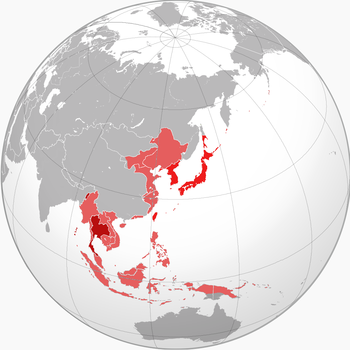Greater East Asia Co-Prosperity Sphere
Japanese imperialist concept / From Wikipedia, the free encyclopedia
Dear Wikiwand AI, let's keep it short by simply answering these key questions:
Can you list the top facts and stats about Greater East Asia Co-Prosperity Sphere?
Summarize this article for a 10 years old
The Greater East Asia Co-Prosperity Sphere (Japanese: 大東亜共栄圏, Hepburn: Dai Tōa Kyōeiken), also known as the GEACPS,[1] was a pan-Asian union that the Empire of Japan tried to establish. Initially, it covered Japan, Manchukuo, and China but as the Pacific War progressed, it also included territories in Southeast Asia.[2] The term was first coined by Minister for Foreign Affairs Hachirō Arita on June 29 1940.[3]

| Greater East Asia Co-Prosperity Sphere | |||||
|---|---|---|---|---|---|
| Japanese name | |||||
| Kana | だいとうあきょうえいけん | ||||
| Kyūjitai | 大東亞共榮圈 | ||||
| Shinjitai | 大東亜共栄圏 | ||||
| |||||
The proposed objectives of this union were to ensure economic self-sufficiency and cooperation among the member states, along with resisting the influence of Western imperialism and Soviet communism.[4] In reality, militarists and nationalists saw it as an effective propaganda tool to enforce Japanese supremacy without provoking significant resistance.[3] The latter approach was reflected in a document released by Japan's Ministry of Health and Welfare, An Investigation of Global Policy with the Yamato Race as Nucleus, which promoted Japanese hegemony in the union.[5] Japanese spokesmen openly described the Great East Asia Co-Prosperity Sphere as a device for the "development of the Japanese race."[6] When World War II ended, the Greater East Asia Co-Prosperity Sphere became a source of criticism and scorn.[7]